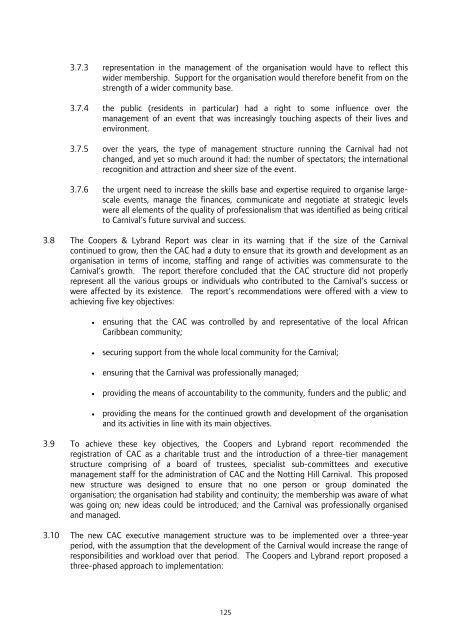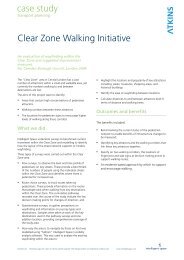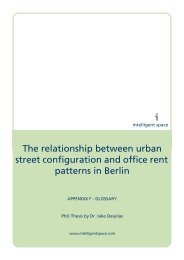Notting Hill Carnival Strategic Review - Intelligent Space
Notting Hill Carnival Strategic Review - Intelligent Space
Notting Hill Carnival Strategic Review - Intelligent Space
Create successful ePaper yourself
Turn your PDF publications into a flip-book with our unique Google optimized e-Paper software.
3.7.3 representation in the management of the organisation would have to reflect this<br />
wider membership. Support for the organisation would therefore benefit from on the<br />
strength of a wider community base.<br />
3.7.4 the public (residents in particular) had a right to some influence over the<br />
management of an event that was increasingly touching aspects of their lives and<br />
environment.<br />
3.7.5 over the years, the type of management structure running the <strong>Carnival</strong> had not<br />
changed, and yet so much around it had: the number of spectators; the international<br />
recognition and attraction and sheer size of the event.<br />
3.7.6 the urgent need to increase the skills base and expertise required to organise largescale<br />
events, manage the finances, communicate and negotiate at strategic levels<br />
were all elements of the quality of professionalism that was identified as being critical<br />
to <strong>Carnival</strong>’s future survival and success.<br />
3.8 The Coopers & Lybrand Report was clear in its warning that if the size of the <strong>Carnival</strong><br />
continued to grow, then the CAC had a duty to ensure that its growth and development as an<br />
organisation in terms of income, staffing and range of activities was commensurate to the<br />
<strong>Carnival</strong>’s growth. The report therefore concluded that the CAC structure did not properly<br />
represent all the various groups or individuals who contributed to the <strong>Carnival</strong>’s success or<br />
were affected by its existence. The report’s recommendations were offered with a view to<br />
achieving five key objectives:<br />
• ensuring that the CAC was controlled by and representative of the local African<br />
Caribbean community;<br />
• securing support from the whole local community for the <strong>Carnival</strong>;<br />
• ensuring that the <strong>Carnival</strong> was professionally managed;<br />
• providing the means of accountability to the community, funders and the public; and<br />
• providing the means for the continued growth and development of the organisation<br />
and its activities in line with its main objectives.<br />
3.9 To achieve these key objectives, the Coopers and Lybrand report recommended the<br />
registration of CAC as a charitable trust and the introduction of a three-tier management<br />
structure comprising of a board of trustees, specialist sub-committees and executive<br />
management staff for the administration of CAC and the <strong>Notting</strong> <strong>Hill</strong> <strong>Carnival</strong>. This proposed<br />
new structure was designed to ensure that no one person or group dominated the<br />
organisation; the organisation had stability and continuity; the membership was aware of what<br />
was going on; new ideas could be introduced; and the <strong>Carnival</strong> was professionally organised<br />
and managed.<br />
3.10 The new CAC executive management structure was to be implemented over a three-year<br />
period, with the assumption that the development of the <strong>Carnival</strong> would increase the range of<br />
responsibilities and workload over that period. The Coopers and Lybrand report proposed a<br />
three-phased approach to implementation:<br />
125








